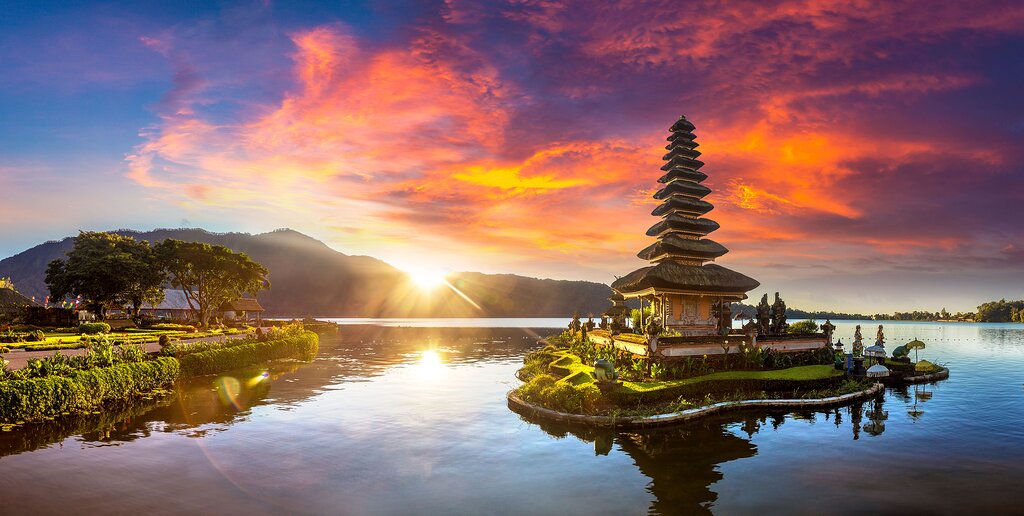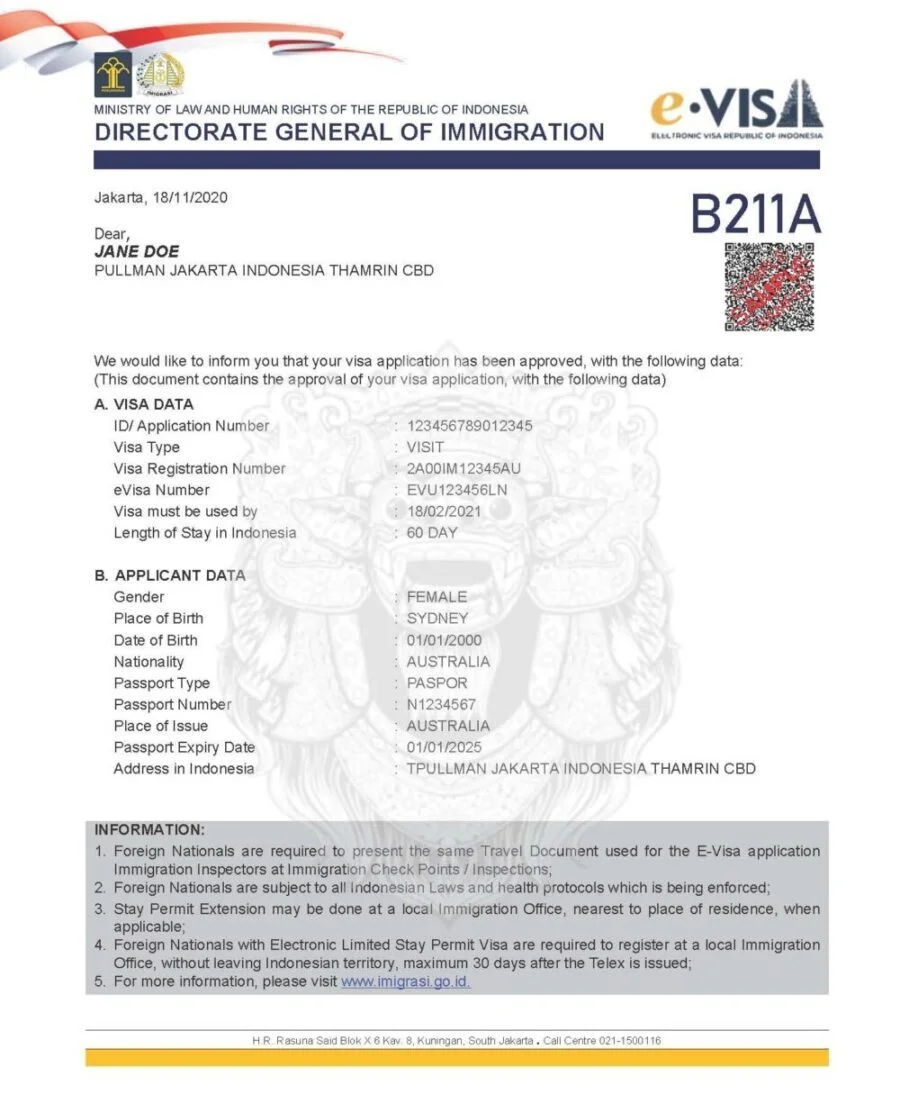Indonesia Visa Eligibility Requirements
Indonesia is often considered a country with flexible visa policies, granting different nationalities multiple entry options. For example, citizens from ASEAN countries, Malaysia, Thailand, and Singapore, are allowed to enter Indonesia visa-free for thirty days. Travelers from the United States, Canada, the United Kingdom, Australia, and most EU countries are eligible for Visa on Arrival (VoA) and e-VOA options. Both permits allow an initial thirty-day stay that is extendable once for another thirty days.
For e-VOA, eligibility is based on nationality; the complete list of eligible countries can be found on the Indonesian immigration website. All travelers also need to satisfy certain conditions like passport validity, proof of onward travel, financial sufficiency, and, in some cases, a recently taken photograph uploaded during the application. Indonesian visa policies are highly strict, and overstaying a VoA can lead to penalties or fines, and timely applications are crucial to avoid these.
Widen Your World - Visa-Free Indonesia Travel for Citizens
Indonesia allows individuals from ASEAN member countries such as Singapore, Thailand, Malaysia, and Vietnam to access the region for up to 30 days without a visa. This grants access to the country's stunning beaches, scenic volcanoes, and rich cultural heritage. The visa-free period cannot be extended, however, and no formal work or study can take place.
Although visa-free, passport holders must still comply with some conditions, such as a valid passport with six months left on it, a ticket for outgoing travel, and enough money. Other travelers can use the VoA or e-VoA options.
Why is the Indonesia Visa Application Online Important for VisitsVisa?
Even though the Indonesian e-VOA system makes Indonesian visa applications accessible and user-friendly, checking the applicant's details is still critical. This is the work of VisitsVisa.com. Their staff assists travelers in filling out the online form accurately, documenting compliance, and preventing other trivial errors that may cause unwanted delays or denials.
With VisitsVisa’s support, your passport photo, proof of funds, itinerary, and other supporting documents will be processed by the Indonesian immigration system. Travelers can now relax without worrying about being burdened by intricate portals or having their applications rejected. For those who qualify for a visa on arrival, VisitsVisa provides informational guidance before travel.
They also assist them in determining if e-VOA or VoA works better in relation to the travel itinerary and reasons for travel. VisitsVisa can also advise you on extension procedures if you wish to stay more than 30 days. Be it family visits, vacations, or business, VisitsVisa.com caters to all your needs and assures a seamless visa experience with expedited processing and meticulous attention to detail.




 Qatar
Qatar  Kuwait
Kuwait Oman
Oman Yemen
Yemen Dubai
Dubai Bahrain
Bahrain Egypt
Egypt India
India  Turkey
Turkey Romania
Romania Russia
Russia Ukraine
Ukraine United Kingdom
United Kingdom Canada
Canada  United State of America
United State of America  Singapore
Singapore Malaysia
Malaysia  Japan
Japan  Thailand
Thailand  Mexico
Mexico  Hong Kong
Hong Kong  Philippines
Philippines Vietnam
Vietnam  Armenia
Armenia  kazakhstan
kazakhstan  Australia
Australia New Zealand
New Zealand South Korea
South Korea South Africa
South Africa Uganda
Uganda Ghana
Ghana Kenya
Kenya Sudan
Sudan Morocco
Morocco Israel
Israel Syria
Syria Lebanon
Lebanon Iran
Iran Iraq
Iraq Azerbaijan
Azerbaijan  Austria
Austria  Belgium
Belgium The czech republic
The czech republic Denmark
Denmark Estonia
Estonia Finland
Finland France
France Germany
Germany Greece
Greece Hungary
Hungary  Iceland
Iceland Italy
Italy Latvia
Latvia Liechtenstein
Liechtenstein Lithuania
Lithuania Luxembourg
Luxembourg Malta
Malta Netherland
Netherland Norway
Norway Poland
Poland Portugal
Portugal Slovakia
Slovakia Slovenia
Slovenia Spain
Spain Sweden
Sweden Switzerland
Switzerland Afghanistan
Afghanistan Albania
Albania Algeria
Algeria American Samoa
American Samoa Andorra
Andorra Angola
Angola Anguilla
Anguilla Antigua and Barbuda
Antigua and Barbuda Argentina
Argentina  Aruba
Aruba  Bahamas
Bahamas  Bangladesh
Bangladesh  Barbados
Barbados  Belarus
Belarus  Belize
Belize  Benin
Benin  Bermuda
Bermuda  Bhutan
Bhutan  Bolivia
Bolivia  Bosnia and erzegovina
Bosnia and erzegovina  Botswana
Botswana  Brazil
Brazil  Brunei
Brunei  Bulgaria
Bulgaria  Burkina Faso
Burkina Faso  Burundi
Burundi  Cambodia
Cambodia  Cameroon
Cameroon  Cape Verde
Cape Verde  Cayman Islands
Cayman Islands  Central African public
Central African public  Chad
Chad  Chile
Chile  China
China  Colombia
Colombia  Comoros
Comoros  Cook Islands
Cook Islands  Costa Rica
Costa Rica  Croatia
Croatia  Cuba
Cuba  Cyprus
Cyprus  Democratic Republic of Congo
Democratic Republic of Congo Djibouti
Djibouti  Dominica
Dominica  Dominican Republic
Dominican Republic  Ecuador
Ecuador  Guinea
Guinea  Guinea
Guinea  El Salvador
El Salvador  Eritrea
Eritrea  Ethiopia
Ethiopia  Faroe Islands
Faroe Islands  Fiji
Fiji  Gabon
Gabon  Gambia
Gambia  Georgia
Georgia  Greenland
Greenland  Grenada
Grenada  Guadeloupe
Guadeloupe  Guam Visa
Guam Visa Guatemala
Guatemala  Guinea
Guinea  Guinea Bissau
Guinea Bissau  Guyana
Guyana  Haiti
Haiti  Honduras
Honduras  Indonesia
Indonesia  Ireland
Ireland  Ivory Coast
Ivory Coast  Jamaica
Jamaica  Jordan
Jordan  Kiribati
Kiribati  Kosovo
Kosovo  Kyrgyzstan
Kyrgyzstan  Laos
Laos  Lesotho
Lesotho  Liberia
Liberia  Libya
Libya  Macau
Macau  Madagascar
Madagascar  Malawi
Malawi  Maldives
Maldives  Mali
Mali  Marshall Islands
Marshall Islands  Martinique
Martinique  Mauritania
Mauritania  Mauritius
Mauritius  Mayotte
Mayotte  Micronesia
Micronesia  Moldova
Moldova  Monaco
Monaco  Mongolia
Mongolia  Montenegro
Montenegro  Mozambique
Mozambique  Myanmar
Myanmar  Namibia
Namibia  Nauru
Nauru  Nepal
Nepal  New Caledonia
New Caledonia  Nicaragua
Nicaragua  Niger
Niger  Nigeria
Nigeria  Norfolk Island
Norfolk Island  Pakistan
Pakistan North Korea
North Korea  North Macedonia
North Macedonia Palau
Palau  Palestine
Palestine  Panama
Panama  Papua New Guinea
Papua New Guinea  Paraguay
Paraguay  Peru
Peru  Puerto Rico
Puerto Rico  Republic of the Congo
Republic of the Congo  Reunion
Reunion  Rwanda
Rwanda  Saint Helena
Saint Helena  Saint Kitts and Nevis
Saint Kitts and Nevis  Saint Lucia
Saint Lucia  Saint Vincent and the Grenadines
Saint Vincent and the Grenadines  Samoa
Samoa  San Marino
San Marino  Sao Tome and Principe
Sao Tome and Principe  Senegal
Senegal  Serbia
Serbia  Seychelles
Seychelles  Sierra Leone
Sierra Leone  Solomon Islands
Solomon Islands  Somalia
Somalia  South Sudan
South Sudan  Sri Lanka
Sri Lanka  Suriname
Suriname  Swaziland
Swaziland  Taiwan
Taiwan  Tajikistan
Tajikistan  Tanzania
Tanzania  Timor-Leste (East Timor)
Timor-Leste (East Timor)  Togo
Togo  Tonga
Tonga  Trinidad and Tobago
Trinidad and Tobago  Tunisia
Tunisia  Turkmenistan
Turkmenistan  Turks and Caicos Islands
Turks and Caicos Islands  Tuvalu
Tuvalu  Uruguay
Uruguay  Uzbekistan
Uzbekistan  Vanuatu
Vanuatu  Vatican City
Vatican City  Zambia
Zambia  Zimbabwe
Zimbabwe  Dubai
Dubai Egypt
Egypt Kuwait
Kuwait Oman
Oman Yemen
Yemen Saudi Arabia
Saudi Arabia Kazakhstan
Kazakhstan UAE
UAE India
India GCC
GCC EU
EU Schengen
Schengen Turkey
Turkey Romania
Romania Russia
Russia Ukraine
Ukraine United Kingdom
United Kingdom Canada
Canada United States of America
United States of America Singapore
Singapore Hong Kong
Hong Kong Japan
Japan Thailand
Thailand Mexico
Mexico Qatar
Qatar Philippines
Philippines Vietnam
Vietnam Armenia
Armenia Azerbaijan
Azerbaijan Australia
Australia New Zealand
New Zealand South Korea
South Korea South Africa
South Africa Uganda
Uganda Ghana
Ghana Kenya
Kenya Sudan
Sudan Bahrain
Bahrain Israel
Israel Syria
Syria Lebanon
Lebanon Iran
Iran Iraq
Iraq Malaysia
Malaysia Austria
Austria Belgium
Belgium Czech Republic
Czech Republic Denmark
Denmark Estonia
Estonia Finland
Finland France
France Germany
Germany Hungary
Hungary Iceland
Iceland Italy
Italy Latvia
Latvia Liechtenstein
Liechtenstein Lithuania
Lithuania Luxembourg
Luxembourg Malta
Malta Netherlands
Netherlands Poland
Poland Portugal
Portugal Slovakia
Slovakia Slovenia
Slovenia Spain
Spain Sweden
Sweden Switzerland
Switzerland Afghanistan
Afghanistan Albania
Albania Algeria
Algeria American Samoa
American Samoa Andorra
Andorra Angola
Angola Anguilla
Anguilla Antigua and Barbuda
Antigua and Barbuda Argentina
Argentina Aruba
Aruba Bahamas
Bahamas Bangladesh
Bangladesh Barbados
Barbados Belarus
Belarus Belize
Belize Benin
Benin Bhutan
Bhutan Bolivia
Bolivia Bosnia and Herzegovina
Bosnia and Herzegovina Botswana
Botswana Brazil
Brazil Brunei
Brunei Bulgaria
Bulgaria Burkina Faso
Burkina Faso Burundi
Burundi Cambodia
Cambodia Cameroon
Cameroon Cape Verde
Cape Verde Cayman Islands
Cayman Islands Central African Republic
Central African Republic Chad
Chad Chile
Chile China
China Colombia
Colombia Comoros
Comoros Cook Islands
Cook Islands Costa Rica
Costa Rica Croatia
Croatia Cuba
Cuba Democratic Republic of the Congo
Democratic Republic of the Congo Djibouti
Djibouti Dominica
Dominica Dominican Republic
Dominican Republic Ecuador
Ecuador El Salvador
El Salvador Equatorial Guinea
Equatorial Guinea Eritrea
Eritrea Ethiopia
Ethiopia Faroe Islands
Faroe Islands Fiji
Fiji Gabon
Gabon Gambia
Gambia Georgia
Georgia Greenland
Greenland Grenada
Grenada Guadeloupe
Guadeloupe Guam
Guam Guatemala
Guatemala Guinea
Guinea Guinea-Bissau
Guinea-Bissau Guyana
Guyana Haiti
Haiti Honduras
Honduras Morocco
Morocco Ireland
Ireland Ivory Coast
Ivory Coast Jamaica
Jamaica Jordan
Jordan Kiribati
Kiribati Kosovo
Kosovo Kyrgyzstan
Kyrgyzstan Laos
Laos Lesotho
Lesotho Liberia
Liberia Libya
Libya Macau
Macau Madagascar
Madagascar Malawi
Malawi Maldives
Maldives Mali
Mali Marshall Islands
Marshall Islands Martinique
Martinique Mauritania
Mauritania Mauritius
Mauritius Mayotte
Mayotte Micronesia
Micronesia Moldova
Moldova Monaco
Monaco Mongolia
Mongolia Montenegro
Montenegro Mozambique
Mozambique Myanmar
Myanmar Namibia
Namibia Nauru
Nauru Nepal
Nepal New Caledonia
New Caledonia Nicaragua
Nicaragua Niger
Niger Nigeria
Nigeria Norfolk Island
Norfolk Island North Korea
North Korea North Macedonia
North Macedonia Pakistan
Pakistan Palau
Palau Palestine
Palestine Panama
Panama Papua New Guinea
Papua New Guinea Paraguay
Paraguay Peru
Peru Puerto Rico
Puerto Rico Republic of the Congo
Republic of the Congo Réunion
Réunion Rwanda
Rwanda Saint Helena
Saint Helena Saint Kitts and Nevis
Saint Kitts and Nevis Saint Lucia
Saint Lucia Saint Vincent and the Grenadines
Saint Vincent and the Grenadines Samoa
Samoa San Marino
San Marino Sao Tome and Principe
Sao Tome and Principe Senegal
Senegal Serbia
Serbia Seychelles
Seychelles Sierra Leone
Sierra Leone Solomon Islands
Solomon Islands Somalia
Somalia South Sudan
South Sudan Sri Lanka
Sri Lanka Suriname
Suriname Swaziland
Swaziland Taiwan
Taiwan Tajikistan
Tajikistan Tanzania
Tanzania Timor-Leste (East Timor)
Timor-Leste (East Timor) Togo
Togo Tonga
Tonga Trinidad and Tobago
Trinidad and Tobago Tunisia
Tunisia Turkmenistan
Turkmenistan Turks and Caicos Islands
Turks and Caicos Islands Tuvalu
Tuvalu Uruguay
Uruguay Uzbekistan
Uzbekistan Vanuatu
Vanuatu Vatican City
Vatican City Venezuela
Venezuela Zambia
Zambia Zimbabwe
Zimbabwe Cyprus
Cyprus Greece
Greece